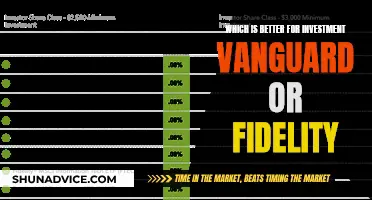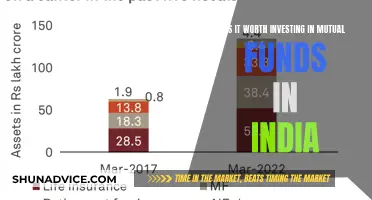
High-yield and investment-grade bonds are two types of bonds with distinct characteristics and risk profiles. High-yield bonds, also known as junk bonds, are debt securities issued by corporations and tend to have lower credit ratings. They offer higher interest rates due to an increased risk of default, making them attractive to investors seeking higher returns. Conversely, investment-grade bonds are considered relatively low-risk investments with lower default probabilities. These bonds usually deliver lower returns compared to high-yield bonds. The classification of bonds as high-yield or investment-grade depends on credit ratings assigned by agencies like Standard & Poor's, Moody's, and Fitch, which assess the risk of default.
| Characteristics | Values |
|---|---|
| Risk | High-yield bonds are considered to have a greater chance of default and are therefore riskier investments than investment-grade bonds. |
| Yield | High-yield bonds offer higher yields than investment-grade bonds. |
| Credit rating | High-yield bonds have lower credit ratings than investment-grade bonds. |
| Issuers | Issuers of high-yield bonds tend to be startup companies or capital-intensive firms with high debt ratios. |
| Volatility | High-yield bonds have historically been more volatile than investment-grade bonds. |
| Liquidity risk | High-yield bonds have higher liquidity risk than investment-grade bonds. |
| Interest rate risk | High-yield bonds are less sensitive to interest rate risk than investment-grade bonds. |
| Default risk | High-yield bonds have a higher default risk than investment-grade bonds. |
| Investor profile | High-yield bonds may be suitable for investors with a long investment time horizon and a high-risk tolerance, while investment-grade bonds may be more suitable for older investors looking to preserve capital. |
What You'll Learn

High-yield bonds are also known as junk bonds
High-yield bonds, also known as junk bonds, are bonds that pay higher interest rates because they have lower credit ratings than investment-grade bonds. They are issued by corporations and are often used by startup companies or capital-intensive firms with high debt ratios. Junk bonds are considered non-investment-grade bonds, with credit ratings below BBB- from Standard & Poor's and Fitch, or below Baa3 from Moody's.
Junk bonds are characterised by their higher risk of default, which makes them more volatile in terms of price fluctuations. The higher risk is reflected in the lower credit ratings assigned by agencies such as Standard & Poor's, Moody's, and Fitch. These ratings indicate the likelihood of the issuing company defaulting on interest or principal payments. Despite the higher risk, junk bonds can provide higher yields than investment-grade bonds, making them attractive to investors seeking higher returns.
The higher yield of junk bonds compensates investors for the added risk. Companies issuing junk bonds typically need to attract investors to fund their operations and are willing to pay higher yields. Junk bonds also have the potential for significant price increases if the issuing company's financial situation improves. This can lead to substantial gains for investors.
Junk bonds serve as a market risk indicator, as their performance is often linked to investors' risk appetite. When the economy is perceived to be improving, investors may be more willing to take on the risk associated with junk bonds, leading to increased buying interest. However, a surge in junk bond investing can also indicate excessive market optimism, potentially signalling an overbought market.
While junk bonds offer the potential for higher returns, they also carry greater risks, including default risk, higher volatility, interest rate risk, and liquidity risk. Investors considering junk bonds should carefully assess their risk tolerance, financial situation, and investment goals before making a decision.
Unlock Real Estate Investing Using Retirement Funds
You may want to see also

High-yield bonds are riskier but can offer higher returns
High-yield bonds, also known as junk bonds, are issued by corporations and tend to be riskier than investment-grade bonds. They are characterised by their lower credit ratings from leading credit agencies. Typically, a high-yield bond will have a rating below BBB- from Standard & Poor's and Fitch or below Baa3 from Moody's.
The higher risk associated with high-yield bonds is due to the greater chance of default. This is because high-yield bonds are often issued by startup companies or capital-intensive firms with high debt ratios. However, they can also be issued by companies that have lost their good credit ratings, known as "fallen angels".
Despite the higher risk, high-yield bonds can offer higher returns than investment-grade bonds. This is because investors must be compensated for taking on more risk, so high-yield bonds pay a higher yield. As a result, high-yield bonds can be attractive to investors with a high-risk tolerance who are seeking higher returns.
High-yield bonds also tend to have shorter maturities and higher interest rates, making them less affected by interest rate changes than investment-grade bonds. Additionally, during economic booms, demand for high-yield bonds increases, and they have been known to outperform lower-yielding bonds.
However, it is important to note that high-yield bonds are not without their disadvantages. They carry a number of risks, including default risk, higher volatility, interest rate risk, and liquidity risk. Due to the higher default risk, diversification strategies may be limited and fees for investors may increase.
High-yield bonds are also less liquid than investment-grade bonds, making them more difficult to resell. Furthermore, changes in the issuer's credit rating or interest rates can affect the value of a high-yield bond, potentially reducing the return on investment.
Overall, while high-yield bonds offer the potential for higher returns, they also come with a higher level of risk. Investors must carefully consider their financial situation, risk tolerance, and investment goals before deciding whether to invest in high-yield bonds.
Diversified Equity Funds: Smart Investment, Smart Returns
You may want to see also

Investment-grade bonds are favoured in a poor economy
Investment-grade bonds are generally favoured in a poor economy. These bonds are considered to have a lower risk of default and are more stable than high-yield bonds. This is because they are issued by companies with stronger credit quality and a higher capacity to repay their loans.
High-yield bonds, also known as junk bonds, are issued by companies with poorer credit quality and a greater chance of defaulting on their debt. As a result, these bonds offer higher interest rates to compensate investors for the higher risk. While high-yield bonds can provide greater returns, they also carry more risk, including default risk, higher volatility, interest rate risk, and liquidity risk.
The classification of bonds as investment-grade or high-yield is determined by credit rating agencies such as Standard & Poor's (S&P), Moody's, and Fitch. These agencies assign letter-based credit ratings to bonds based on their risk profile and the likelihood of repayment. Bonds with good credit ratings of at least 'BBB-' by S&P and Fitch, or 'Baa3' by Moody's, are considered investment-grade.
The demand for investment-grade bonds typically increases during poor economic conditions as investors seek lower-risk investments. On the other hand, high-yield bonds are favoured when the economy is performing well and investors are willing to take on more risk in exchange for potentially higher returns.
Additionally, investment-grade bonds usually have higher durations, as a larger proportion of their total income is received through the repayment of principal at maturity. This makes them more sensitive to changes in interest rates. In contrast, high-yield bonds have shorter maturities and receive a larger proportion of their payments through coupons, making them less affected by rising interest rates.
Overall, investment-grade bonds are preferred by investors seeking lower risk and capital preservation, especially during poor economic conditions.
Mutual Funds in India: Invest Without a Broker
You may want to see also

High-yield bonds can be part of a diversified portfolio
High-yield bonds, also known as junk bonds, are an integral part of an investor's portfolio. They are debt securities issued by corporations with lower credit ratings than investment-grade bonds. While they carry more risk, they also offer higher yields, making them attractive to investors seeking higher returns.
High-yield bonds can be an essential component of a diversified portfolio. Here's why:
Higher Returns
High-yield bonds offer the potential for higher returns compared to investment-grade bonds. They provide higher yields or coupons, making them appealing to investors seeking to maximize their income. The higher returns can be especially beneficial for investors with high income requirements.
Diversification
High-yield bonds have a low correlation with investment-grade fixed-income sectors, such as Treasuries and highly-rated corporate debt. By adding high-yield securities to a broad fixed-income portfolio, investors can enhance diversification and reduce overall portfolio risk. Diversification helps to decrease volatility and improve the consistency of returns.
Capital Appreciation
High-yield bonds offer the potential for capital appreciation in addition to income. An economic upturn or improved performance by the issuing company can positively impact the price of a high-yield bond. This capital appreciation is a significant component of a total return investment approach.
Equity-like Returns with Lower Volatility
High-yield bonds tend to respond similarly to equities in the overall market environment, leading to similar return profiles over a full market cycle. However, returns on high-yield bonds are generally less volatile due to the larger income component of the return. High-yield bonds can, therefore, offer equity-like total returns over the long term but with lower risk.
Relatively Low Duration
High-yield bonds often have shorter maturities, leading to relatively low duration. They are typically issued with terms of ten years or less and are sometimes callable after four or five years. This low duration makes them less sensitive to interest rate risk, especially in a rising rate environment.
In conclusion, high-yield bonds can be a valuable addition to a diversified portfolio. They offer the potential for higher returns, provide diversification benefits, and have the potential for capital appreciation. However, investors should carefully consider the risks associated with high-yield bonds, including default risk and volatility. By including high-yield bonds as part of a well-balanced portfolio, investors can seek to maximize returns while managing risk effectively.
Aquamarine Fund: A Guide to Investing in Water's Treasure
You may want to see also

High-yield bonds are issued by corporations
High-yield bonds, also known as junk bonds, are issued by corporations. They are debt securities that pay higher interest rates than investment-grade bonds, but they also carry a higher risk of default. Issuers of high-yield debt tend to be startup companies or capital-intensive firms with high debt ratios. The higher interest rates compensate investors for the higher risk of default.
High-yield bonds are typically issued by companies with poorer credit quality, and they carry lower credit ratings from leading credit agencies. In terms of credit ratings, high-yield bonds tend to have ratings below BBB- from Standard & Poor's and Fitch, or below Baa3 from Moody's.
High-yield bonds are often used by emerging companies seeking working capital for expansion or to fund acquisitions. They can provide these companies with financing opportunities, but they also come with higher risks and potentially greater risk of default.
High-yield bonds have shorter maturities and are less likely to have call protection. This means that if a company's financial condition or credit rating improves, the issuer can call its outstanding bonds and take advantage of lower funding rates.
Overall, high-yield bonds issued by corporations offer higher returns but carry more risk. They are suitable for investors with a high-risk tolerance and a long investment time horizon, as there is a potential for capital losses in the short term.
Best Tracker Funds: Where to Invest Your Money
You may want to see also
Frequently asked questions
High-yield bonds are debt securities, also known as junk bonds, that are issued by corporations. They are rated below BBB- or Baa3 by established credit rating agencies.
An investment-grade bond is a rating that signifies a municipal or corporate bond that presents a relatively low risk of default.
High-yield bonds typically offer higher returns than investment-grade bonds, but they also carry more risk and have a lower credit rating. Investment-grade bonds are considered to have a low risk of default and usually deliver lower returns.
Credit rating agencies such as Standard & Poor's (S&P), Moody's, and Fitch use letter grades with plus (+) and minus (-) suffixes to indicate a bond's credit quality rating. For example, AAA and AA are considered high credit quality, while BBB is the lowest tier of investment-grade.
High-yield bonds can provide diversification benefits to an investment portfolio due to their low correlation with other sectors of the fixed-income market. They also have the potential for price appreciation during economic upturns or improved performance of the issuing company. However, investors need to carefully monitor the financial health of the issuing companies as these bonds carry higher default risk.







